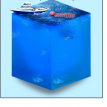Crown of Thorns Starfish (COTS) outbreaks reporting
15 August 2015
Revised on 16th August 2015, 0815hrs: Crown of thorns starfish or COTS are one of the largest species of starfish (Asteroidea). There are four species of COTs, and Acanthaster Planci is responsible for coral mortality in the Northern Indian Ocean and the coral triangle (Vogler, Benzie, Lessios, Barber, & Wörheide, 2008). A. Planci can grow larger than 80 cm in diameter and can have more than 30 arms. The thorns that cover their upper surface are long and sharp, and coated with a saponin toxin which causes irritation to puncture wounds.
COTs feed on coral polyps by spreading across living corals and pushing its stomach out on to the corals, leaving behind scars on the corals from where they’ve been feeding. This behaviour has a very important ecological role, in which the older coral communities are removed, creating space for new recruitments. Their preference to feed on the faster growing coral types also makes it possible for the slower growing corals to thrive. Despite their ecological importance in maintaining coral diversity, the fact that they actively feed on corals become a threat to the reef systems if the populations are not kept under controlled. COTs outbreaks are identified as a major contributor to reef degradation, and a major concern in the indo-pacific.
Why do COTS outbreaks occur?
The main reasons for outbreaks from published research are 1) over-fishing of the natural predators of COTs, like the humphead wrasse, giant triton snail, sweetlip emperor, starry puffer fish and a solitary polyp Pseudocorynactis a corallimorph (Bos, Gumanao, & Salac, 2008). 2) increase in the plankton load due to nutrient enrichment in the water, resulting in favourable conditions for larval settling.
Observing more than 15 COTs per hectare (or 2 COTs in a 20 minute swim) is considered an outbreak according to the Great Barrier Reef marine Park Authority (GBRMPA) of Australia (“Crown of thorns starfish CONTROL GUIDELINES,” 2014).
COTS outbreaks occur annually in several parts of the Maldives. Several resorts in Male atoll and Ari atoll are reporting COTS outbreaks this year.
Controlling COTS outbreaks
There are two main methods of controlling COTS outbreaks. 1) Injecting single shot bile salts or multi-shot sodium biosulphate into the animals; and 2) Physically removing the COTS from the reefs (“Crown of thorns starfish CONTROL GUIDELINES,” 2014).
Injecting chemicals that are toxic to the COTs is considered the best technique for COTs control, because these chemicals used are usually toxic just to the COTs, leaving the surrounding intact. However, access to such chemicals might prove difficult in many cases, and might need to resort to their physical removal from the waters, and burying them on land. Both these techniques are very labour intensive.
Many confuse coral bleaching with COTS feeding on corals. A bleached coral will be bleached but intact, and a COTs fed coral will appear white, but feeding scars.
Reporting
Report COTS outbreaks to us simply by filling the online reporting form for COTs. Click here. for the form. Feel free to contact us should you need additional guidance or assistance to carry out COTS removal operation.
Here is the Crown of Thorns control guideline from the Great Barrier Reef Marine Park Authority (GBRMPA) of Australia.
References
Bos, a. R., Gumanao, G. S., & Salac, F. N. (2008). A newly discovered predator of the crown-of-thorns starfish. Coral Reefs, 27(January), 581. doi:10.1007/s00338-008-0364-9
Crown of thorns starfish CONTROL GUIDELINES. (2014). Townsville: Great Barrier Reef Marine Park Authority.
Lucas, J. S. (2013). Crown-of-thorns starfish. Current Biology, 23(21), R945–R946. doi:10.1016/j.cub.2013.07.080
Vogler, C., Benzie, J., Lessios, H., Barber, P., & Wörheide, G. (2008). A threat to coral reefs multiplied? Four species of crown-of-thorns starfish. Biology Letters, 4, 696–699. doi:10.1098/rsbl.2008.0454





